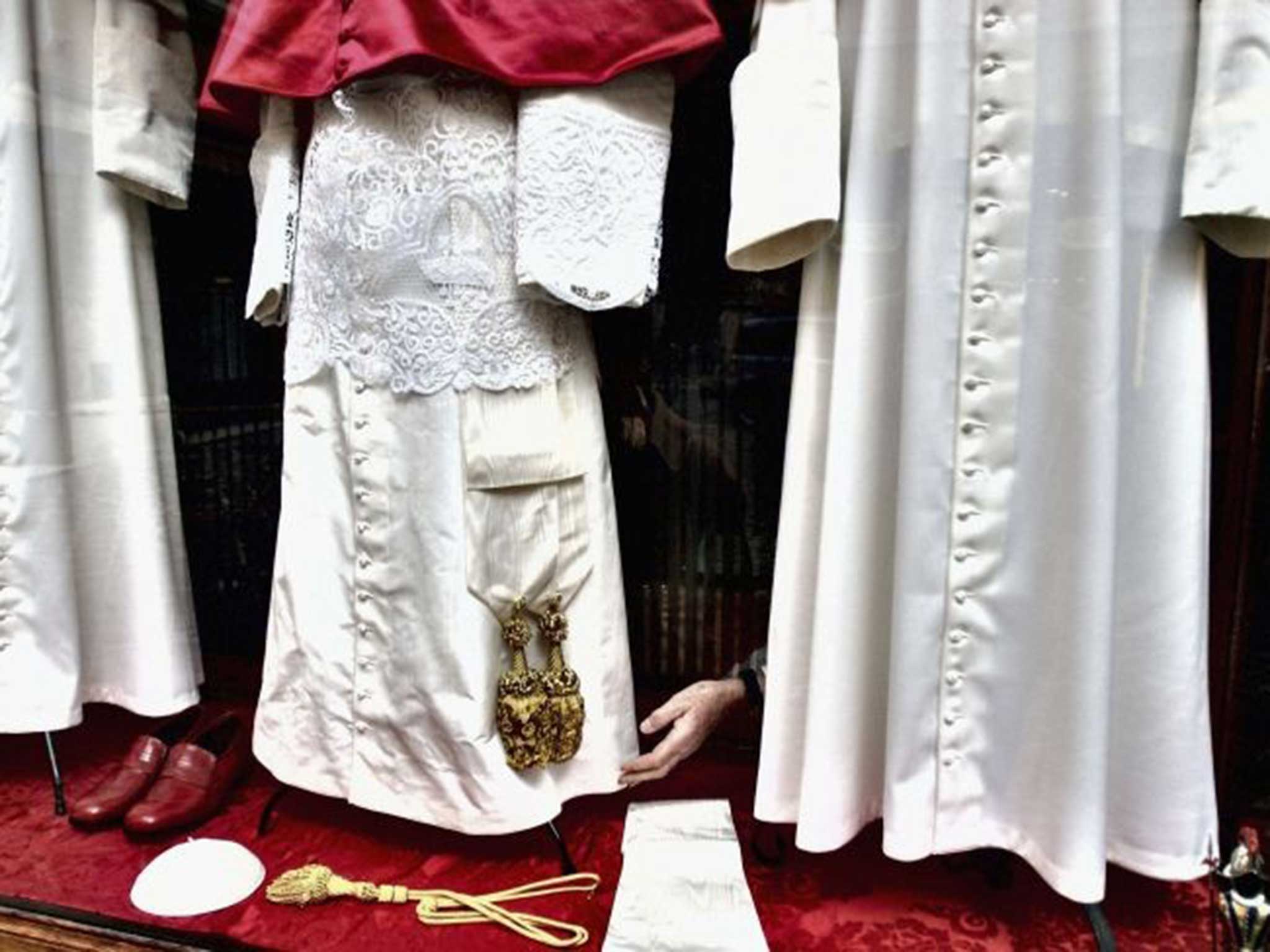Vatican chic today: Out with the ermine, in with the nylon as clergy copy the Pope's simplicity
Rome's clerical outfitters report downturn in business

Your support helps us to tell the story
From reproductive rights to climate change to Big Tech, The Independent is on the ground when the story is developing. Whether it's investigating the financials of Elon Musk's pro-Trump PAC or producing our latest documentary, 'The A Word', which shines a light on the American women fighting for reproductive rights, we know how important it is to parse out the facts from the messaging.
At such a critical moment in US history, we need reporters on the ground. Your donation allows us to keep sending journalists to speak to both sides of the story.
The Independent is trusted by Americans across the entire political spectrum. And unlike many other quality news outlets, we choose not to lock Americans out of our reporting and analysis with paywalls. We believe quality journalism should be available to everyone, paid for by those who can afford it.
Your support makes all the difference.The reign of Pope Francis is not only shaping the great moral and theological debates of the day.
The former Cardinal Bergoglio has also torn up the sartorial stylebook, and the rest of Italy’s clerics are tossing aside their robes and ermine in an attempt to ape his back-to-basics style.
Hemlines are supposed to drop with share prices in periods of crisis, but in austerity-struck Rome, long luxurious robes are out and the austere Argentine pontiff’s grunge style – more Francis of Assisi than Cesare Borgia – is in.
And now clerical outfitters are complaining that Rome’s priests and cardinals of all ranks are less ready to splash out thousands of euros for silk and hand-embroidered garments. Even €400 (£317) for a wool cassock or €1,260 for a chasuble, is eliciting requests for cheaper alternatives. For Rome’s holy men, rather than silk, no-nonsense nylon is the order of the day.

As a result, takings are down in the clerical outfitters that are spread around Rome’s Piazza Minerva. In these large, morbid establishments, with odd medieval garments in the widow and something of the undertakers about them, the atmosphere is even more ashen than normal. Luciano Ghezzi, 75, the owner of the outfitter in Via dei Cestari, told La Stampa newspaper that times were hard. “Priests, bishops and cardinals want cheaper clothing and items from lower price ranges because they know that Pope Francis does not approve of them wearing fine clothes or luxury accessories,” he said.
“Today, priests and prelates dress in a very basic and spartan way. There are virtually no bishops with gold crosses on their chests.”
Mr Ghezzi, who has dressed Rome’s clergy for 57 years, said that traditions were at risk. “Pope Bergoglio is extraordinary and moves me deeply with his commitment to his flock. But his line of austerity and sobriety has overshadowed the secular heritage of traditional craftsmanship in ecclesiastical clothing.”
What a difference a couple of years make. In December 2011, the press reported that it was all smiles at Rome’s Gammarelli tailors with news that the Vatican had come shopping. The shop was commissioned to kit out six newly elected cardinals from the US, India, Nigeria, the Philippines, Lebanon and Colombia. This meant supplying them all with a pair of cassocks – one red, one black – at around €1,500. Then there were red mozzetta hoods at €200 a pop; three-pointed hats at €100, zucchetto skull caps and special red socks, as well as a fascia or sash at €120. Each cardinal got two sets of each of these outfits, which brought the total order to €5,000 per cardinal.
This, however, was during the reign of Pope Benedict, a traditionalist with a penchant for white fur and red slippers, which looked curiously like footwear by Prada.
After Benedict’s historic abdication in February 2013, his successor from Argentina said he wanted today’s Catholic Church to resemble Francis of Assisi’s “Church of the poor”. Minutes after his election in March 2013, Pope Francis symbolically shunned the traditional papal red cape trimmed with ermine that Benedict XVI liked to wear on ceremonial occasions. “No thank you, Monsignor,” Pope Francis is reported to have said. “You put it on instead. Carnival time is over.”
And Francis underlined this in October last year when he summoned Franz-Peter Tebartz-van Elst, Limburg’s “Bishop of Bling”, to Rome for a dressing-down after it emerged that the German churchman had spent €31m renovating his dioceses residence, including €350,000 for walk-in wardrobes.

But in Rome some of the clerical outfitters are adapting to the changing times. On the other side of the River Tiber, just a stone’s throw from St Peter’s Square, the capital’s version of H&M for clergy, Euroclero, is tempting priests with a polyester chasuble with machine-stitched designs for €60 and complete chalice and ciborium (to contain the Eurachrist) sets for just €125.
“As soon as you walk into some of these ecclesiastical tailors you realise immediately that something is changed, and rightly so,” said the Salesian Bishop Enrico dal Covolo, rector of the Pontifical Lateranense University. “There is a search for a greater simplicity to make it clear that the Church must stand by vocation with the poor, especially in these times of severe economic crisis.”
Join our commenting forum
Join thought-provoking conversations, follow other Independent readers and see their replies
Comments